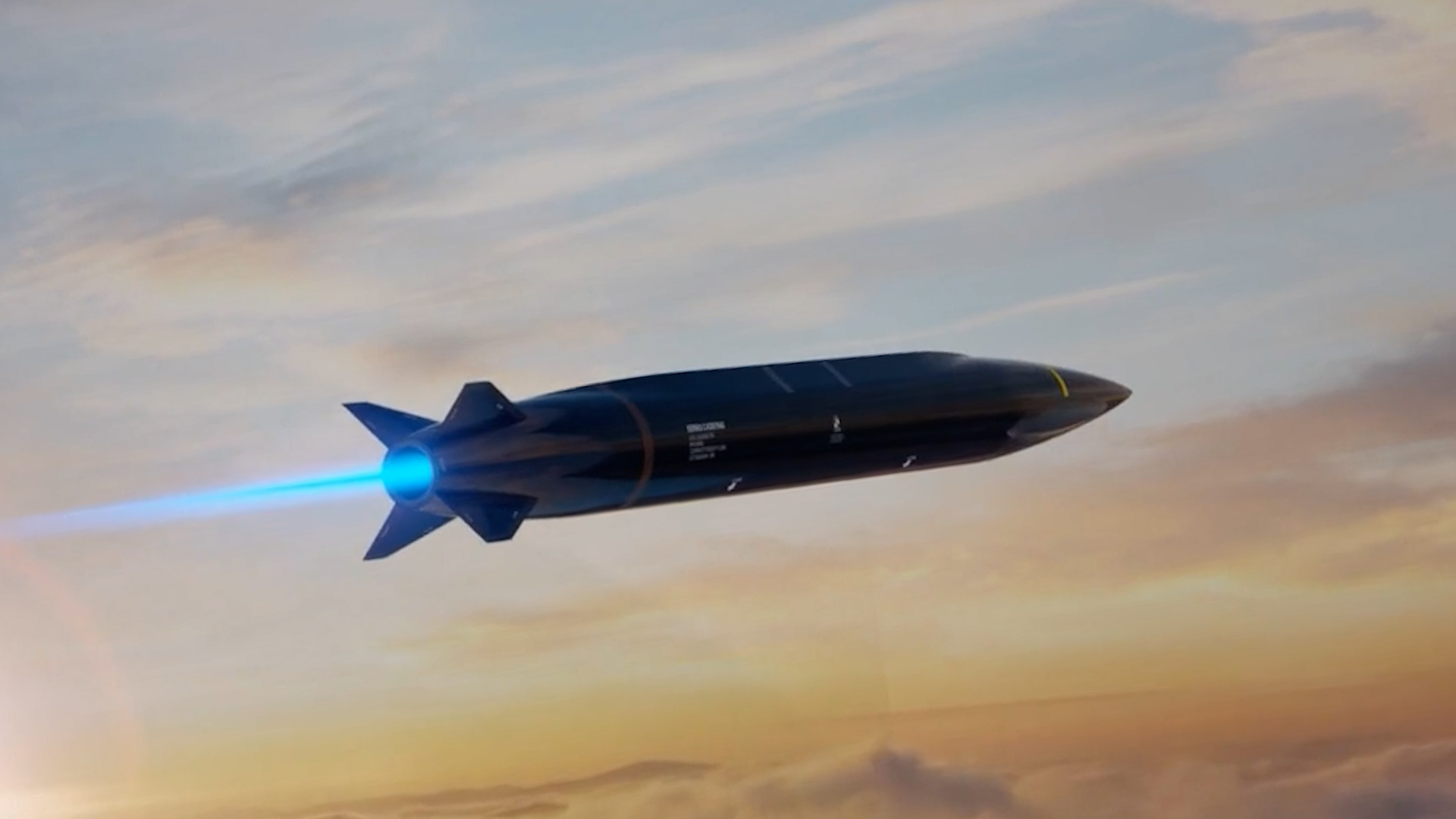
Ryan Robertson
ONE OF THE LIKELY BIG TOPICS OF DISCUSSION HERE THIS WEEK IS THE PROLIFERATION OF HYPERSONIC WEAPONS AND WHERE THE U-S STANDS CONCERNING ITS NEAR-PEER ADVERSARIES. I RECENTLY HAD TO CHANCE TO VISIT WITH LOCKHEED MARTIN’S DIRECTOR OF AIR DOMINANCE AND STRIKE WEAPONS ADVANCED PROGRAMS ABOUT THEIR ENTRY INTO THE CONVERSATION…
THE MAKO.
Scott “Fish” Fisher, Lockheed Martin
“The Mako is the fastest shark in the ocean. So we started this seven years ago. Came up with a clever name for it, but the more clever part was coming from, where I had just come in operational tests for the United States Navy Marine Corps, where we went out and evaluate evaluated the latest weapon systems for the Navy. Coming from that I knew that there were some capability gaps, and that’s a fancy way of saying requirements. Capability gap is red. Can do a certain mission. Blue, the US can do a certain mission, if there’s a gap there, then we want to close that gap. That becomes a big R requirement, and by Red and Blue, red is OP force blue is friendly. Force Red’s our adversary, yes, and blue is a us and our allies knew that there was a capability gap out there, across various mission areas, and wanted to close that gap with a single weapon. So about seven years ago, 2017 since then, we’ve spent, you know, 100 and $50 million investment, seven years of work with the government and internally with Lockheed Martin and it Mako, is a weapon that happens to be hypersonic. Hypersonic isn’t a weapon, right? That’s that hypersonic is a speed, but it’s a weapon that was developed to be multi mission, multi platform, multi domain. What the heck does that mean? Multi mission means, you know, taking out ships, taking out tanks, taking out air defenses, really, any mission that you can think of multi platform is this weapon literally can hang on anything that has 30 inch lugs. So we fit on all the teenagers, F 18, F 16, F 15, all the bombers out there, your mobility platform, like C 17 and and c1 30 so being able to be delivered via palletized and yes, and then internally and externally, on, internally, on our fifth generation platforms, F 22 and F 35 we’ve we’ve done those physical fit checks, and then and hanging externally on those platforms, and then multi domain. What does that mean? Well, we’ve been talking about air launched here. But what about surface launch, which is maritime, which is from the ocean? What about ground launched from the land? What about subsurface launch from a submarine. So it’s really it’s the One Ring to rule them all. It packs quite a punch in the end game. The missile itself is the missile of 13 it’s 1300 pounds. It’s 13 and a half inches in diameter. It’s got 130 pound warhead, and it’s 13 feet long.”
Ryan Robertson
THE HYPERSONIC COMPONENT. I MEAN, SO THERE’S SO MUCH TALK ABOUT CHINA’S HYPERSONIC WEAPONS, THEIR MISSILES, LIKE THE DZ 17, OR WHATEVER THEY CALL IT. NOW, WHEN, WHEN YOU SET OUT TO DO THIS SEVEN YEARS AGO, THAT NECESSARILY ALL THE HYPERSONIC TALK WASN’T TAKING UP ALL THE AIRWAVES AS IT IS NOW. SO WAS THE DIFFERENCES, I GUESS. I MEAN, FOR THE LAYMAN, WHEN THEY SEE HYPERSONIC OR HEAR HYPERSONIC, IT’S JUST SUPER FAST, RIGHT? SO HOW DOES, HOW DOES THE MAKO DIFFER THAN THE CHINESE VERSION OF A HYPERSONIC WEAPON.
Scott “Fish” Fisher, Lockheed Martin
“Mach Five, for all intents and purposes, is about 50 miles a minute. So the rough rule of thumb, it’s not exact at 25,000 feet, it tends to almost correlate, but it’s about Mach one is about 10 miles a minute. So keep that as a reference frame. So think about that, 50 miles a minute, you’re almost going a mile a second.”
Ryan Robertson
SO AT THIS POINT NOW, LIKE YOU’RE YOU’RE THERE, WAITING FOR THE CUSTOMER, THE GOVERNMENT WITH, WITH THE PRODUCT READY TO GO, IS THAT LIKE AN ACCURATE DESCRIPTION OF IF, IF THEY WANT TO START PUTTING DOLLARS TOWARDS THIS THING, THEN ADDITIVE MANUFACTURING, ALL OF THE COMPONENTS ARE THERE. IT’S ALL IT’S ALL THE RIGHT, THE SUPPLY LINES ARE ALL ESTABLISHED. THIS THING CAN GO INTO PRODUCTION FAIRLY QUICKLY.
Scott “Fish” Fisher, Lockheed Martin
“So in general, yes, so we’ve been ready past 18 months. We haven’t been on contract for 18 months since we know that we are still ready to move out rapidly, whether that is the traditional route, going through the a what, as I stated, that full EMD phase, engineering, manufacturing, decision phase, and all of the milestones that that occur there. It’s, it’s, well, it’s very. Prescriptive, or we could go into something traditionally called a rapid prototyping so if a customer wanted to, hey, let’s, let’s, let’s build one of these things. Let’s, let’s. Elon Musk this, you know, space, SpaceX, let’s, let’s fail fast, fail early, if need be, and learn from it. And let’s get this out there as soon as possible the warfighter, we could take that route also, yes, we were at the point where we had the global supply chains identified. We had all of that lined up, but we didn’t go to the next piece which, which was to get onto that EMD contract. So we could, we could pivot fairly fast now. We haven’t been just sitting around the past 18 months. We have continued to look internationally. We’ve continued to keep our our domestic partners here, up to speed on what’s going on the US, government and various services have have asked for various briefs over the past 18 months, keeping an awareness of where we are. We’ve looked at alternative warheads in that timeline. And I think the biggest, the biggest thing that has occurred is the, as you brought up, Brian, the additive manufacturing piece since the inception seven years ago of Mako, the world has changed. From from a from a, you know, manufacturing standpoint, we are able to, I’m not going to throw out dollars here, I’ll just give you percentages and orders of magnitude, but we are able to take something that used, for instance, the guidance housing up front used to be made out. We call it subtractive manufacturing, not added subtractive, meaning you take this very expensive piece of metal, you hog it out, you weld stuff together. It takes a lot of time and and it’s very wasteful with additive manufacturing now we’re actually building up that component from the constituent parts, and we are able to do that, and I’m not kidding here, in 1/10 of the time, and 1/10 the cost, that’s that’s revolutionary, that’s not evolutionary, that’s significant, and that’s because the advances in in production capability for the better balance of a decade have changed tremendously. It’s all about, you know, how fast can you it’s not just about the quality that has to remain, but it’s the quantity. How many of these units can you put out per month? And as we’ve seen in Ukraine and other places, it’s about production capability, and it’s about getting weapons out there quickly. You can just make one or two a year. What’s the point? If? But if you can ramp up and produce that rate, and do it from from a, from a cost perspective, that’s, that’s a track.”
Ryan Robertson
LAST QUESTION I HAD FOR YOU, FISH AS A FORMER FIGHTER PILOT. HOW HOW MUCH WOULD YOU HAVE WANTED THE MAKO IN IN YOUR BAYS, IF YOU COULD HAVE HAD IT?
Scott “Fish” Fisher, Lockheed Martin
“So, so thank you for asking that this was the weapon that I always wanted. That’s why I’m so passionate about this. I still have many of my junior officers from 10 years ago are now out there, the commanding officers of fighter squadrons, some of my training officers my squadron now drive around the nation’s capital ships are aircraft carriers, the most capable ships in the world. I made a promise to them, and I want to keep that promise. I need to get the best equipment to them, because there’s storm clouds on the horizon, and we want to make sure, through strength, that that we have peace. And it’s it’s important, this is what I wanted on my aircraft, and I know this is what they want also.”
Ryan Robertson
THAT WAS PERFECT FISH. REALLY APPRECIATE IT. THANK YOU SO MUCH.











